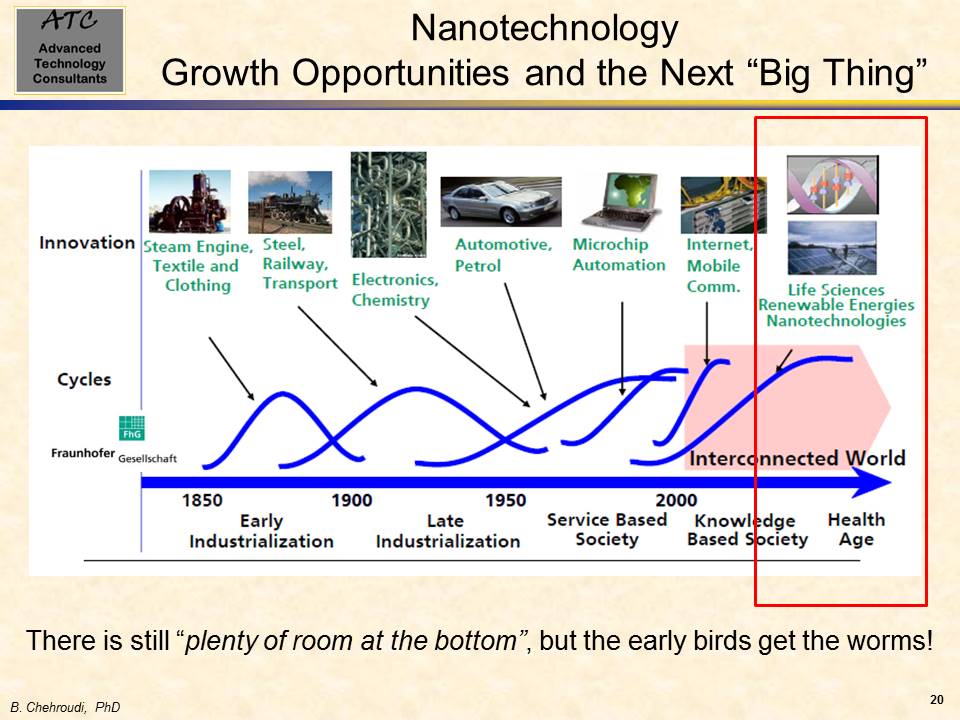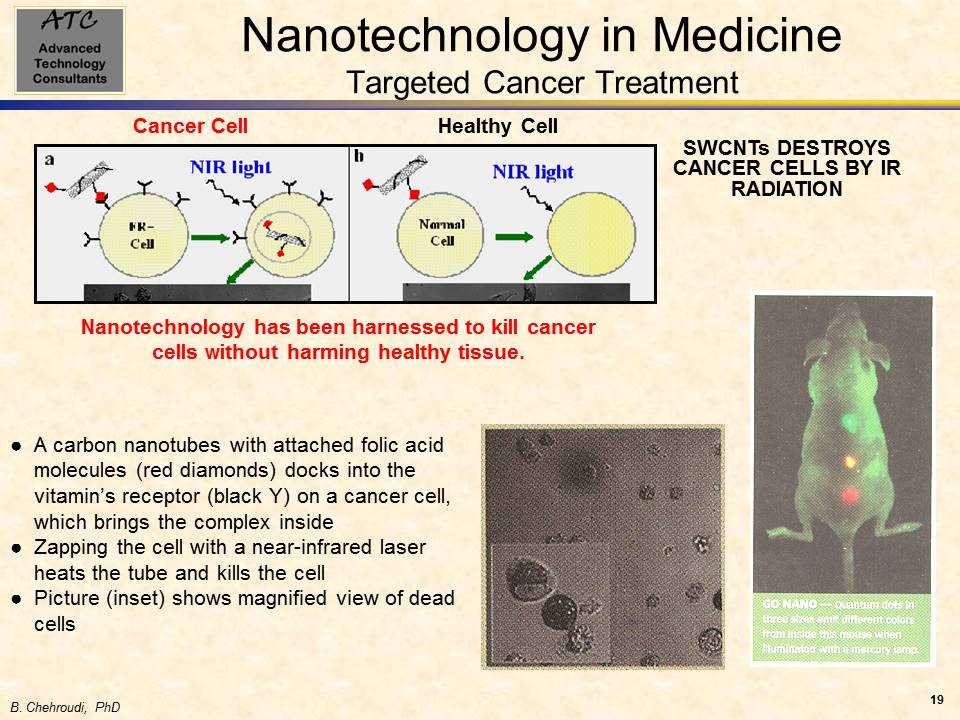Advanced Technology
Consultants |
home | help | email |
Welcome to

Advanced Technology Consultants
Laguna Niguel, California
USA 92677
Tel: 949 467 9233
(001 prefix outside USA)
Lugano, Ticino
Switzerland 6900
| Nanotechnology: Current Status and Future Outlook |
 |
|
The US government goes as far as suggesting that in just another 10 to 15 years, nanotechnology will impact more than $1 trillion per year in products and services. The idea of building and working with structures in the “nano”-scale world goes back to Nobel laureate Richard Feynman’s famous lecture on December 29th, 1959 at California Institute of Technology titled “There’s Plenty of Room at the Bottom.” He envisioned engineering materials one atom at a time, a “bottom-up” approach. An entity with a micron in diameter is (1/1000) of a meter and a “nano” sized object is (1/1000) of a micron, a dimension difficult to imagine and feel. For example, a human hair is about 50 to 100 microns (m) in diameter, a white blood cell is about 10 microns, and a DNA is in the order of 10 nanometers (nm). Building brick by brick using atoms required tools unavailable in 1959. One approach is to hope that once these building blocks are unloaded on a land, they automatically form a desired building through the magical self-assembly properties observed in molecular world. One breakthrough
enabling technology towards bottom-up approach was demonstrated
by IBM researchers in 1982. Binning and Rohrer invented the
scanning tunneling microscope (STM) and won the noble prize in
1986. The atomic force microscope (AFM) was shortly after
invented by Binning and Rohrer as well. It is now widely
accepted that scanning probe techniques, including AFM,
constitute a key enabling tool for nanotechnology. Another key
element in nanotechnology is chemical self-assembly, the
self-organization of small molecular components to form complex
functional structures. As the feature length scale reaches the
70 nm or less in lithography through implementation of tools
such as F2 lasers, and the fact that biological scales are in
the nano size ranges, the nanotechnology is seen to heavily
interact/overlap with biotechnology and microelectronics.
James Canton, President of the Institute for Global Futures stated, "Never has such a comprehensive technology promised to change so much so fast... Inevitably, nanotechnology will give people more time, more value for less cost and provide for a higher quality of existence.” Also, based on a broad definition that considers most biotechnology the "wet side" of nanotechnology, Rice chemistry professor and Nobel Laureate Richard E. Smalley likes to say that "it holds the answer, to the extent there are answers, to most of our most pressing material needs in energy, health, communication, transportation, food, water, etc." Finally, The US government goes as far as suggesting that in just another 10 to 15 years, nanotechnology will impact more than $1 trillion per year in products and services. This seminar attempts to instill a sense of understanding and appreciation for the significance of this revolutionary (nano-) technology of the 21st century, and elevate knowledge of the field for the technologists, managers, business people, entrepreneurs and the investment community. This is accomplished through dissemination of a balanced and high-fidelity information on scientific, existing and potential products, and business opportunities for the near-, intermediate- and long-term. This seminar aims to position the attendees to intelligently benefit from current and future nanotechnology products and other related opportunities in their technical and business activities. Who should attend:
Educational Objectives Upon completing this course students should be able to:
Table of Contents:
Lead Instructor:
Instructor:
Bruce Chehroudi Dr. Chehroudi, has accumulated years of technical and leadership experiences in different capacities and organizations. This includes such positions as a Principal Scientist and Group Leader appointment at the Air Force Research Laboratory (AFRL) ERCInc, a Chief Scientist at Raytheon STX, a Visiting Technologist at Ford’s Advanced Manufacturing Technology Development (AMTD) center, a tenured Professor of Mechanical Engineering at Kettering University and University of Illinois, and served as a Senior Research Staff/Research Fellowship at Princeton University. Dr. Chehroudi directed numerous multimillion dollar interdisciplinary projects in areas involving chemically reacting flows, combustion and emission of pollutants, sustainable and alternative energy sources, distributed ignition, material/fuel injection, advanced pollution reduction technologies, propulsion concepts, gas turbine and liquid rocket engines, combustion instability, laser optical diagnostics, spectroscopy, supercritical fluids and applications in environmental and propulsion systems, advanced composites, MEMS, nanotechnology, and micro fluidics. He has won many merit and leadership awards by such prestigious organizations as the Society of Automotive Engineers (1. Arch. T. Colwell Merit Award for technical excellence only to top 1% yearly, 2. Ralph R. Teetor Award for outstanding teaching/research/leadership, 3. Forest R. McFarland Award for sustained leadership in professional and educational service and a key contributor to the Continuing Professional Development Group, 4. Appreciation Award for 10 years of dedicated and inspiring service and commitment to providing quality technical education, and 5. Outstanding Faculty Advisor), American Institute of Aeronautics and Astronautics (Best Publication Award of the Year), Air Force Research Laboratories (1. Outstanding Technical Publication Award, and 2. STAR Team Award for demonstrating world-class combined scientific and leadership achievements), Institute of Liquid Atomization and Sprays Systems (Marshall Award for best publication with lasting contributions), Liquid Propulsion Sub-committee of Joint Army-Navy-NASA-Air Force (JANNAF) (Best Liquid Propulsion Paper Award involving undergraduate/graduate students), and the 2nd International Symposium on Turbulence and Shear Flow Phenomena (Top 10 Technical Publication Award). He has been a consultant with many organizations such as, Ford, GM, Honda R&D, AFRL, Honeywell, NASA, AFOSR, VW, Bosch, Siemens, NGK, Cummins, and TRW. Through professional societies, Dr. Chehroudi delivers invited professional seminars on Management of R&D Teams and Organizations, Management of Innovation, Combustion and Emission of Pollutants in Automotive and Gas Turbine Engines, Ignition Issues, Gasoline Direct Injection engines, R&D on Homogeneously-Charged Compression Ignition (HCCI) engines, and Liquid Injection Technologies. He has a PhD in Mechanical & Aerospace Engineering and Post-Doctoral Fellow (Princeton University), MS in Mechanical Engineering (Southern Methodist University, Summa Cum Laude), MS in Economics (Swiss Finance Institute, Magna Cum Laude), a senior member of American Institute of Aeronautics and Astronautics Propellant & Combustion Committee (2008-present), and is an Associate Fellow of American Institute of Aeronautics and Astronautics. Dr. Chehroudi acts as a reviewer for many scientific and engineering journals and publishers, has delivered over 200 presentations in technical meetings and to nontechnical audiences, over 20 technical reports (Princeton University, General Motors, Ford Motor Co, Department of Energy, NASA, Air Force Research Laboratory), five 600-plus-page monographs on combustion and emission of pollutants from mobile power plants, ignition technologies, liquid material injection, and nanotechnology, two book chapters on propulsion system combustion instability and applications of graphene (a nanotech product) in ignition and combustion of fuels, ground-breaking patents on applications and synergy between nanotechnology, light, and chemical reaction for a light-activated distributed ignition of fuel-air mixtures, and has more than 150 publications with extensive experience in both scientific and management areas and intensive trainings in finance and financial engineering
________________________ NOTE: Contact Advanced Technology Consultants for consulting needs and opportunities in this area. Copyright 2017 - Advanced Technology Consultants- All Rights Reserved |
|


